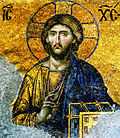True Orthodox Church
| ||||||||||||||||
| Part of a series on |
| Eastern Christianity |
|---|
 |
|
Liturgy and worship |
|
The Russian True Orthodox Church is a denomination that separated from the Russian Orthodox Church during the early years of Communist rule in the Soviet Union. It is a part of what is called True Orthodoxy. While the True Orthodox Church in Russia was never a single organization, many of its followers were labeled Josephites, after Metropolitan Joseph (Ivan Petrovykh) of Leningrad, the leader of its largest branch.
Origin
The death of Patriarch Tikhon, the leader of the Russian Orthodox Church in April 1925 led to unrest among the followers of the church. Tikhon's designated successors were arrested by the civil authorities and Metropolitan Sergius was named '"locum tenens," or a cleric designated to substitute for another. Sergius issued a declaration in 1927 calling all members of the church to profess loyalty towards the Soviet government. The declaration sparked division among the hierarchy, clergy, and laity, which led to the formation of the Russian True Orthodox Church.
Opposition to Sergius's declaration was based not only on his political concessions, but also on canonical and theological disagreements. His alliance with the authorities allowed him to turn over to the civil authorities all hierarchs, or church administrators, and clergy who were at odds with him on both political and church-related issues.
Underground
Many church members and clerics were opposed to Sergius in church doctrine and backed the stand of the new True Orthodox Church. Most of them tried to observe Soviet law. Yet the Soviet authorities had taken their stand in the dispute and were prepared to use whatever means necessary to bring the bishops under the control of their favorite, Sergius. This control by the Soviets caused True Orthodox Church eparchies (geographical areas under control of a bishop) and communities to go underground for the entire Soviet period.
In the 1970s and 1980s, many of these communities had lost their last bishops and many of their priests. They were forced to exist underground and celebrate services without a spiritual leader.
Emergence
With the change in Russian political life in the late 1980s, the True Orthodox Church began to make itself known publicly. Individual fellowships solved the question of their future in different ways: Some of them joined the Russian Orthodox Church Outside of Russia, which by that time had begun to operate within the country itself. Others, like the Russian True Orthodox Church, Metropolis of Moscow, renewed their episcopacy and clergy through arrangements made with other jurisdictions.
In 1996 a group of Russian Orthodox clergy and laity approached Patriarch Dymytriy of the Ukrainian Autocephalous Orthodox Church (UAOC), to ask for assistance in restoring a hierarchy for what was to be named the Russian True Orthodox Church. In June 1996, with the blessing of Patriarch Dymytriy, Archbishop Roman, and Bishop Mefodiy (later Metropolitan Mefodiy) of the UAOC, Hieromonk John was ordained a bishop of the Russian True Orthodox Church in order to restore apostolic succession. In December 1996 Bishops John and Mefodiy ordained Archimandrite Stefan a bishop for the Russian True Orthodox Church. These two bishops, John and Stefan, might thereupon pass the succession to the rest of the bishops of the Russian True Orthodox Church.
Contemporary church
In 2000 the Russian True Orthodox Church officially added "Metropolis of Moscow" to its name to distinguish it from other groups within Russia.
.jpg)
Today, the church is led by Metropolitan Alexy (Bondarenko) of Moscow and all Russia, together with Archbishop Mikhail of Bronitsk and Velensk, Archbishop Hermogen (Danilov-Volin) of Odessa and Kiev and all Ukraine, Archbishop Haralampos (Yong) (Western Rite), and Archbishop Vladimir (Rosenthal)of Ramensk.
| Preceded by Metropolitan Vyacheslaw (Lisovoj) |
Metropolitan of Moscow and all Russia (RTOC-MM) 2012–present |
Succeeded by Metropolitan Alexy (Bondarenko) |
See also
- List of Orthodox Churches